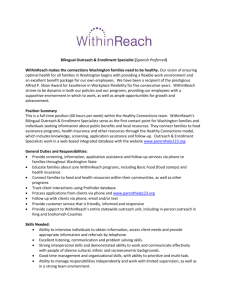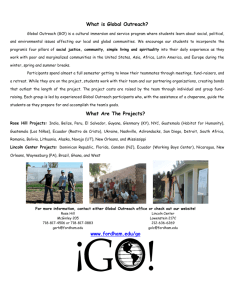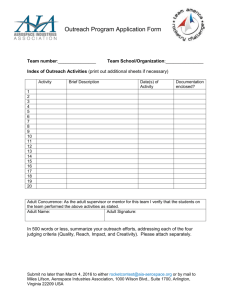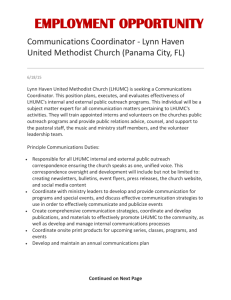PPT - Outreach Science
advertisement
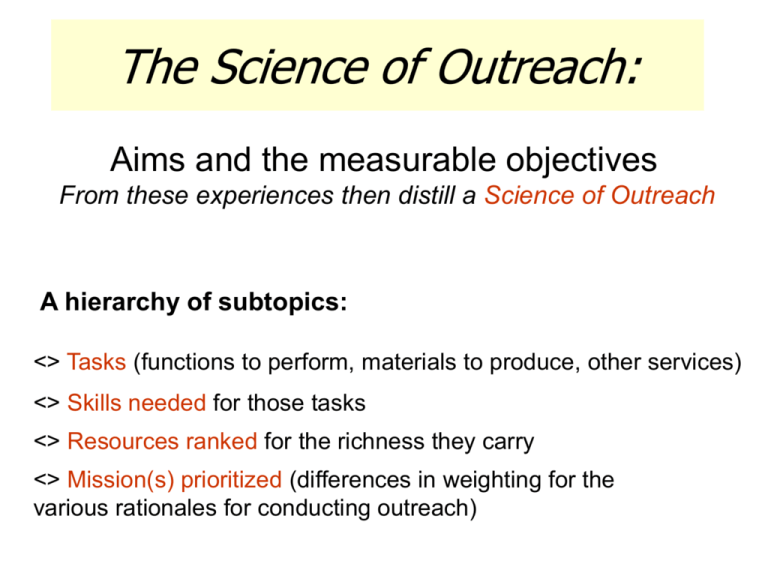
The Science of Outreach: Aims and the measurable objectives From these experiences then distill a Science of Outreach A hierarchy of subtopics: <> Tasks (functions to perform, materials to produce, other services) <> Skills needed for those tasks <> Resources ranked for the richness they carry <> Mission(s) prioritized (differences in weighting for the various rationales for conducting outreach) Why Study the Nature of Outreach? • structure: identify the elements • function: understand how these work Defining Your Outreach with Numbers • people reached • distance of reach; of grasp • frequency & longevity of contact Defining Your Outreach Qualitatively • wider knowledge & experience • extending world view • respectful, inquisitive, self-aware • changed habits of behavior Essence of Outreach • Visibility: • Accessibility > Greater access - visual analogies • build the roads • make the cars • create products and deliver • bridge maker: on-ramp, footing, deck Products Available; Services Performed • estimate the short and long-term success • with modification, rate the revised success • within all your outreach - how important? Asking the Big Questions • • • • How big can we dream? Which function matters most? Most expedient; efficient pr/sv? At logical extreme: what results? Newcomer’s Guide • • • • • • • • • • • • • • • [1] WORKING PRACTICES [2] SKILL SET (see “My Digital Toolbox” wioc session 1-C) [3] E-LISTS and newsletters to subscribe to [4] PROMOTIONAL & ADVOCACY (s.o.p. & f.a.q.) [5] COMPUTER-1, Toolbar (desktop Quicklaunch) [6] COMPUTER-2, Folders (my outreach drive) [7] ANNUAL CYCLE (reports, events) [8] SOME OF MY BOOKMARKS [9] FOOD FOR THOUGHT www.oneminutevacation.org www.umich.edu/~wittevee/korea/andjapan www.aasianst.org/eaa-toc.htm www.edutopia.org http://earth.google.com www.uwm.edu/Dept/CLACS/resources/nrc_lrc.html By the 5th of May 2006 http://outreachscience.tripod.com/home.html New to Outreach? In order to sustain all outreach purposes, one needs to be acquainted with: 0. Mission (general aims & targeted objectives) & the operative principles Spark interest [breadth of coverage] in people, places, languages and issues; then feed that interest [introduce depth of coverage] 1. Establish CONNECTIONS with constituents (think Highway Network) 2. Create the occasions/OPPORTUNITIES to engage them (think Vehicles on those roads) 3. PRODUCE materials and services of greatest use to them (think Products in the vehicles) Biggest step: visibility and seizing chances to make constituents aware of your offerings Crowning step: give easy access to the assets you have (pictures, recordings, campus collections, speakers and performances) as well as those you have permission to adapt (publications and other authored works) derivatively: stills from a DVD, spoken excerpts from recorded voice, transcript or translation of a session paper, slide taken from a Powerpoint presentation. Guiding Principles in Outreach Principle 1: Piggy-back on another event or occasion that convenes your constituents (e.g. teachers) for their convenience. Principle 2: Repurpose your presentation: e.g. original Powerpoint can be adapted as PDF for convenient Web filesize and printout. By giving audience the spoken version, paper handout and (Web) access to a softcopy that they can edit or adapt for use, you serve them well. Principle 3: Offer small filesize and easy navigation to your content. Connectivity to Internet is often limited by dialup connection, or lack of discretionary browsing time. More Guiding Principles Principle 4: Multiplier effect. Any visits you make for your Center can double by mentioning peer centers, too, thus lending visibility to colleagues. In the same spirit, things that have worked well you should freely recommend to colleagues. Collected names that indicate topic or world region of interest can easily accommodate colleague's Centers, too: share namelists as you cultivate your own interest groups. Principle 5: Archive or back up your materials regularly to guard against IT vagaries! Likewise "common sense," track attendance numbers regularly for (grant) reporting purposes; or keep credit-bearing events in a folder for easy tallying periodically. Principle 6: Supervisor support for the work of outreach is important. Most public universities will have something like this in their mission: create knowledge, main and teach it, and disseminate worthy results to the people of the state to improve the conditions of living. Clearly it is outreach above all others that is concerned with this applied dimension. 1. Typical constituents to serve • Educators of social studies, foreign languages, art/music/physical education) and their administrators, their students; • librarians and museum people; the general public; • home school organizations, community colleges; • Intermediate School Districts, State Ed. Departments; • Councils of Social Studies and their subsections for history, geography, economics and civics; • preservice teachers and their Ed. Schools; • non-profit organizations that are engaged or concern themselves with your part of the world 2. Outreach skills: • • • • • • • • event planning networking language/culture competence curriculum development editing knowledge of constituencies advocacy & vision reporting 3a. Main Outreach functions: Consultant to those seeking help Agent for those you serve Advocate (push relevance & visibility) Author Transformer (repurpose others’ content) 3b. Skill set for those functions • Comfortable with email (keeping folders for attachments and projects; CC and BCC when efficient or advisable) • Compose, capture and edit visual material to best effect (motion and sound are nice, too) in hardcopy or screen-based presentations or webpages • Meeting and event planner knack for details and (project) timelines. • Promotional capabilities: advertising/announcements most likely to reach target constituents. • First-hand experience of the language(s) and societie(s) within one's particular region. • Familiarity with school, classroom and student-teacher dynamics and scope of limitations. • Awareness of university culture and its horizon of expectations, its preoccupations and the types of projects most likely supported (or on the contrary, most likely resisted). 4a. List of key hardware • Digital camera with sound+video feature (*.mov, Quicktime format or AVI motion JPEG), tripod, 512mb memory, 3x optical zoom • Sony Hi-MD minidisc recorder and mic (audio zips onto PC; not Mac) ----extended lecture or performance (50 minutes > 8 min. transfer) ----excerpting DVD, CD, v-CD, TV, LP, radio, line-in (onto MD >PC) http://outreachscience.tripod.com/toolbox.html summarizes "My Digital Toolbox" 4b. List of key software Acrobat PDF full version, adobe.com/acrobat Quicktime Pro ($29.95), apple.com/quicktime Audacity (free audio editor) sourceforge.net Picasa2 (free photo manager) google.com/downloads 4c. List of outreach products • activity or worksheet supplements; guides • (online) captioned photo albums • narrated slideshow capsule presentations • mp3 recordings of (excerpted) campus speakers or performers 5. Evaluation methods signs of success or indicators of corrective action • testimonials invited or unsolicited (keep an 'atta-boy' folder) • traditional survey sheets at middle and/or endpoints of the activity • participants' own standards or indicators to define meaningful impact • external, generic forms developed for crosscenter use Taking action: design research for these key questions 1. What quality/depth of impression is achieved by each outreach product or service (relative merit or effectiveness)? 2. What factor, moment or series of events led present experts to their commitment: new grad students, recent hires, mid-career, full-professors 3. How best to streamline the conduit function from potential asset at home campus to one's primary constituents? 4. How best to conceptualize a hierarchy among the several main functions performed by outreach (visibility, accessibility by adapting materials, et cetera) Seek answers to outreach (2) design research for these key questions 5. What are the special strengths of (university based NRC, Title VI) Area Studies Centers that distinguish it from other content sources? 6. What are the particular weaknesses or other limitations in Area Studies Centers to be mindful of? (and thus to accommodate well) 7. How to gather best practices (showcase) and use to instruct (how-to)? As measured by what criteria? 8. What should the terminology for this budding science include? What distinctions are important to make? 9. How might a suggested Standard of Practice either advance the cause of improving the field, or conversely hinder it? Taking action: design research for these key questions 10. Organizationally, how best to support and encourage leadership in this scientific pursuit through structure and funding? 11. If that it were: Suppose all these questions were answered and a clear map of the terrain were sketched, and eventually all programs of outreach were to develop to their full potential of integral engagement with the direction of each constituency (k14 classrooms, news media, business and government leaders), then how might the public consciousness and degree of sophistication about intercultural communication look? In other words, what signs will indicate that the full intent of (international education) Outreach has been realized? If outreach reaches its full promise (a) Foreign language will be a normal elective; taking more than one will be acceptable. (b) Domestic issues and course matter will always implicitly and explicitly be viewed in a cross-cultural, global or comparative perspective. (c) Classes other than the social studies and foreign language will crossreference those concepts and distinctions. (d) Conversations with persons ethnically different to oneself will be animated and much anticipated, not anxious or threatening; conversational topics and cautions will be well known (respectful curiosity, accommodating non-native speaking limits, self-aware of one's own ethnic character from the other person's standpoint). (e) Concepts like 'cultural politics', cultural relativism, (reverse) culture shock, limitations of translation, and maybe even (cultural) hegemony will have been seen in action and be familiar to some extent. In short, all young people will see culture at work all around themselves and the other people in their lives, as well as in each society elsewhere in the past and presentday world. By the 5th of May 2006 http://outreachscience.tripod.com/home.html

